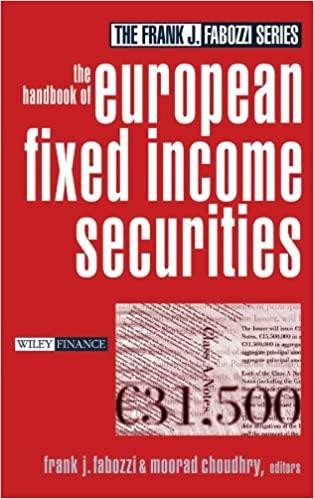Question
Case: In December 2004, R. E. Torgler was trying to decide whether to add a new line of injection molded plastic products to those already
Case: In December 2004, R. E. Torgler was trying to decide whether to add a new line of injection molded plastic products to those already manufactured and distributed by Reto S.A. In order to do so, the firm would have to buy new injection molding equipment; none of the existing equipment could be adapted to perform the necessary operations, and Torgler was anxious to retain control of manufacturing. Actually, new injection molding equipment of the type needed had been considered before, but a decision to purchase the equipment had been postponed because the product concept was judged to need additional development. But now the products seemed ready.
Sales of the new product were forecast at SFr. 2,000,0001 per year, from which a sales commission of 15 percent would be paid to Retos sales agents. Direct manufacturing costs were budgeted at SFr. 600,000 for materials and SFr. 900,000 for labor, leaving an annual cash flow before taxation of SFr. 200,000. The new equipment would cost SFr. 600,000, delivered and installed, and was expected to have an economic life of 10 years before it would become worthless.
Reto was able to borrow money at 8 percent, although it did not plan to negotiate a loan specifically for the purchase of this equipment.
Questions: Answer 5-9
5. Reto has learned that investment in working capital (receivables and inventories, less payables) amounts to approximately 15 percent of sales. Will the additional SFr 300,000 investment for the new line decrease the rate of return on investment to less than the 12 percent criterion Torgler has been using? 6. In late December 2004, Reto purchased the equipment, and the operating results turned out as forecast. A year later, Torgler learned that the manufacturer of the equipment had introduced new models which were more automated. The new equipment sold for SFr. 1,000,000 and would permit labor savings of SFr. 200,000 per year, thus doubling the net operating cash flow on the product. As a result of the technological advance, Torgler expected the one-year-old machine could be sold for only SFr. 200,000 despite the fact that its book value was SFr. 400,000. If Reto buys the new machine and depreciates it using allowed tax depreciation over 10 years, would the investment meet the 12 percent after-tax criterion? 7. If the one-year-old machine had no salvage value at all, would replacing it with the new machine still be desirable? 8. Torgler was loathe to throw away a nearly new machine and thought he might be better off to keep it one more year and then replace it. Would he be better off? How would you go about addressing this issue? 9. During 2005, the rate of inflation remained low, and it was expected that it would average about 4 percent for the year. Torgler wondered how Retos analysis should reflect this rate of inflation, which he expected might continue for several years. Advise Torgler on this issue.
(1-4 are for reference, don't need to answer)
1. Ignoring the effect of taxes, what is the internal rate of return (IRR) on the proposed investment. Assume the new equipment would be installed by January 1, 2005, and begin producing on that date. 2. The cost of the equipment can be deducted from annual cash flows before they are subjected to taxation. Assuming that the equipment will last 10 years, and that an equal amount of the cost of SFr. 600,000 will be deducted each year, and that the tax rate is expected to be 45 percent, what is the IRR on an after-tax basis? 3. Torgler has stated that Reto should be willing to purchase this machine as long as it yielded a return of 12 percent after taxation. Should he make the investment? 4. Actually, to stimulate industrial development, the tax rules allow up to one third of the cost of any such investment to be deducted from cash flows in the first year after the investment, and up to one-fifth of the remainder of the unamortized investment amount can be deducted in the second year. Thereafter, annual deductions are computed on a straight-line basis such that no more than the original cost of the equipment is depreciated over its economic life. How, if at all, does this tax rule affect the attractiveness of the investment?
Step by Step Solution
There are 3 Steps involved in it
Step: 1

Get Instant Access to Expert-Tailored Solutions
See step-by-step solutions with expert insights and AI powered tools for academic success
Step: 2

Step: 3

Ace Your Homework with AI
Get the answers you need in no time with our AI-driven, step-by-step assistance
Get Started


